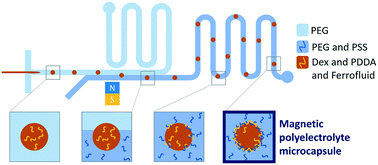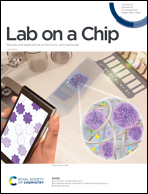Magnetic polyelectrolyte microcapsules via water-in-water droplet microfluidics†
Abstract
Polyelectrolyte microcapsules (PEMCs) have biocompatible microcompartments. Therefore, PEMCs are useful for applications in cosmetics, food, pharmaceutics, and other industries. The fabrication of PEMCs often involves the use of harsh chemicals or cytotoxic organic phases that make biomedical applications of the microcapsules challenging. In this report, we present an all-aqueous droplet microfluidics platform for the generation of magnetic PEMCs. In the platform, we use an aqueous-two-phase system (ATPS) of polyethylene glycol (PEG) and dextran (Dex), to generate water-in-water droplets, which are magnetically functionalized with ferrofluid. Strong polyelectrolytes (PEs) with opposite charges are used in each ATPS phase. We make emulsion templates of magnetic Dex, containing the polycations, in a continuous phase of PEG. We then apply a magnetic field to move the magnetic droplets to a second PEG phase, which contains the polyanions. By careful tuning of the fluxes of the two PEs in their respective phases, we trigger the formation of a shell at the droplet interface. Owing to the presence of the ferrofluid, the resulting microcapsules are magnetically responsive. We show that the magnetic PEMCs are capable of passive release of large pseudo-drugs as well as triggered release using external stimuli such as osmotic shock and pH change. We expect that magnetic PEMCs from this biocompatible all-aqueous platform will find utility in the fabrication of functionalized drug carriers for targeted drug delivery.



 Please wait while we load your content...
Please wait while we load your content...